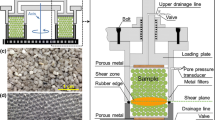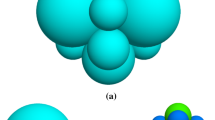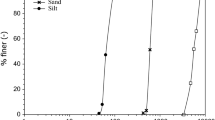Abstract
Cohesionless granular matter subjected to internal flow can incur an internal erosion by suffusion characterized by a migration of its finest constituting particles. A series of suffusion tests is performed on assemblies of gap-graded glass beads using a large oedo-permeameter device. Two successive processes of erosion can be observed during the tests. First, a suffusion process is characterized by a progressive and diffuse migration of fine particles over a long time period. The second process, induced by the first one, is characterized by a strong migration over a short time period (blowout of fine particles) and produces rapidly large settlement of specimen. Time series of hydraulic conductivity, longitudinal profile of specimen density, eroded mass and axial deformation are analyzed. The initial content of fine particles and the history of hydraulic loading appear as key parameters in the suffusion development. To characterize the suffusion development, erosion rate is investigated according to the power expended by the seepage flow, and a new law of erosion by suffusion is proposed.



















Similar content being viewed by others
References
Alexis A, Le Bras G, Thomas P (2004) Experimental bench for study of settling-consolidation soil formation. Geotech Test J 27:557–567
Bendahmane F, Marot D, Alexis A (2008) Experimental parametric study of suffusion and backward erosion. J Geotech Geoenviron Eng 134:57–67
Bonelli S (ed) (2012) Erosion in geomechanics applied to dams and levees. ISTE, Wiley
Bonelli S, Marot D (2011) Micromechanical modeling of internal erosion. Eur J Environ Civil Eng 15:1207–1224
Burenkova VV (1993) Assessment of suffusion in noncohesive and graded soils. In Proceeding 1st Conference Geo-Filters, Karlsruhe, Germany, Balkema, Rotterdam, The Netherlands, pp 357–360
Chang DS, Zhang LM (2011) A stress-controlled erosion apparatus for studying internal erosion in soils. Geotech Test J 34(6):579–589
Chang DS, Zhang LM (2013) Critical hydraulic gradients of internal erosion under complex stress states. J Geotech Geoenviron Eng 139(9):1454–1467
Fell R, Fry JJ (2007) Internal erosion of dams and their foundations. Taylor & Francis Publisher, London
Kenney TC, Lau D (1985) Internal stability of granular filters. Can Geotech J 22:215–225
Kovacs G (1981) Seepage hydraulic. Elsevier, Amsterdam
Lade PV, Yamamuro JA (1997) Effects of non plastic fines on static liquefaction of sands. Can Geotech J 34(6):918–928
Li M (2008) Seepage induced instability in widely graded soils. PhD Thesis, University of British Colombia, Vancouver
Li M, Fannin J (2008) Comparison of two criteria for internal stability of granular soil. Can Geotech J 45:1303–1309
Marot D, Bendahmane F, Rosquoët F, Alexis A (2009) Internal flow effects on isotropic confined sand–clay mixtures. Soil Sediment Contam 18:294–306
Marot D, Regazzoni PL, Wahl T (2011) Energy based method for providing soil surface erodibility rankings. J Geotech Geoenviron Eng 137:1290–1294
Marot D, Le VD, Garnier J, Thorel L, Audrain P (2012) Study of scale effect in an internal erosion mechanism. Eur J Environ Civil Eng 16:1–19
Marot D, Bendahmane F, Nguyen HH (2012) Influence of angularity of coarse fraction grains on internal erosion process. La Houille Blanche 6:47–53
Moffat R, Fannin RJ (2006) A large permeameter for study of internal stability in cohesionless soils. Geotech Test J 29:1–7
Moffat R, Herrera P (2014) Hydromechanical model for internal erosion and its relationship with the stress transmitted by the finer soil fraction. Acta Geotechnica. doi:10.1007/s11440-014-0326-z
Perzlmaier S (2007) Hydraulic criteria for internal erosion in cohesionless soil. In: Fell R, Fry JJ (eds) Internal erosion of dams and their Foundations. Taylor & Francis, London, pp 179–190
Reddi LN, Lee I, Bonala MVS (2000) Comparison of internal and surface erosion using flow pump test on a sand-kaolinite mixture. Geotech Test J 23:116–122
Sail Y, Marot D, Sibille L, Alexis A (2011) Suffusion tests on cohesionless granular matter. Eur J Environ Civil Eng 15:799–817
Scholtès L, Hicher PY, Sibille L (2010) Multiscale approaches to describe mechanical responses induced by particle removal in granular materials. Comptes Rendus Mécanique (CRAS) 338(10–11):627–638
Shire T, O’Sullivan C (2013) Micromechanical assessment of an internal stability criterion. Acta Geotech 8:81–90. doi:10.1007/s11440-012-0176-5
Sibille L, Lominé L, Poullain P, Sail Y, Marot D (2015) Internal erosion in granular media: direct numerical simulations and energy interpretation. Hydrol Process 29(9):2149–2163. doi:10.1002/hyp.10351
Skempton AW, Brogan JM (1994) Experiments on piping in sandy gravels. Géotechnique 44:449–460
Sterpi D (2003) Effects of the erosion and transport of fine particles due to seepage flow. Int J Geomech 3:111–122
Tong AT, Catalano E, Chareyre B (2012) Pore-scale flow simulations: model predictions compared with experiments on bi-dispersed granular assemblies. Oil Gas Sci Technol 67(5):743–752. doi:10.2516/ogst/2012032
Vallejo LE (2001) Interpretation of the limits in shear strength in binary granular mixtures. Can Geotech J 38:1097–1104
Vincens E, Witt KJ, Homberg U (2014) Approaches to determine the constriction size distribution for understanding filtration phenomena in granular materials. Acta Geotechnca. doi:10.1007/s11440-014-0308-1
Wan CF, Fell R (2008) Assessing the potential of internal instability and suffusion in embankment dams and their foundations. J Geotech Geoenviron Eng 134:401–407
Wood DM, Maeda K, Nukudani E (2010) Modelling mechanical consequences of erosion. Géotechnique 60(6):447–457
Author information
Authors and Affiliations
Corresponding author
Rights and permissions
About this article
Cite this article
Sibille, L., Marot, D. & Sail, Y. A description of internal erosion by suffusion and induced settlements on cohesionless granular matter. Acta Geotech. 10, 735–748 (2015). https://doi.org/10.1007/s11440-015-0388-6
Received:
Accepted:
Published:
Issue Date:
DOI: https://doi.org/10.1007/s11440-015-0388-6




